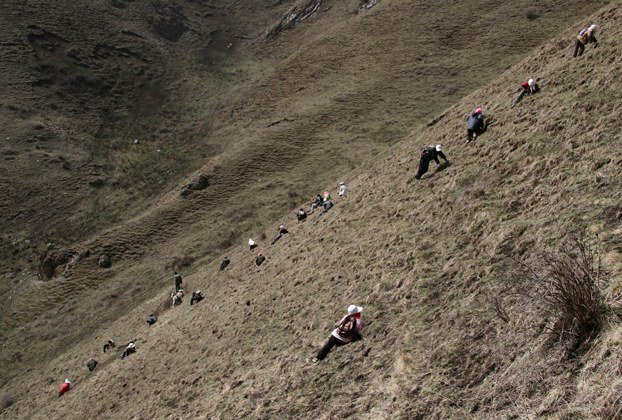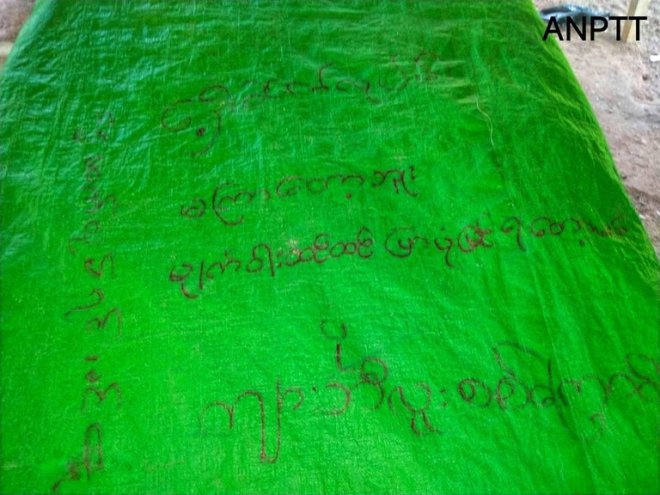Shrinking harvest of caterpillar fungus puts squeeze on Tibetan herders
Gathered in the Tibetan highlands, caterpillar fungus can fetch US$18,000 a pound, and in rare cases more than US$50,000 a pound.It’s a traditional medicine used for centuries to treat heart, liver and lung diseases, high cholesterol, low libido and impotence, despite a lack of scientific evidence.
But during the May peak harvest season this year, collectors have had a harder time finding the slender brown root-like fungus, known as yartsa gunbu, or “summer grass, winter worm,” yarsagumba or Himalayan Viagra.
Tibetans herders who collect the fungus to boost their meager incomes blame a shortage of rain, changing climate and over-harvesting amid rising demand..
“Production is already on the decline every passing year,” a Tibetan living in Kardze’s Dege county told Radio Free Asia. “Before, collectors would easily gather at least 100 pieces of caterpillar fungus, but now the most they can collect is 40 in a day. Some even say they can collect only 10 a day.”
Research published in 2018 in the Proceedings of the National Academy of Sciences journal said the decline of caterpillar fungus in the Himalayan region was due to climate change and overharvesting.
 A picker digs out a caterpillar fungus, used in traditional medicine, along the Amne Machin mountain range in western China"s Qinghai province, in an undated photo. Credit: Reuters file photo
A picker digs out a caterpillar fungus, used in traditional medicine, along the Amne Machin mountain range in western China"s Qinghai province, in an undated photo. Credit: Reuters file photo
Its value jumped during the COVID-19 pandemic as people sought the fungus as treatment for the virus. And prices have also risen as Chinese, Mongolians and others try to get into the business of collecting and selling the fungus, he said.
“That is now making it difficult for everyone to thrive due to limited production,” he said.
These days, the lower quality fungus sells for about 30 yuan, or US$4.25, each, while the better quality fungus goes for 50-60 yuan (US$7-8.50) each, said a Tibetan who lives in Kardze Tibetan Autonomous Prefecture, a Tibetan-populated area of Sichuan province.
In China, where the fungus is highly regarded, its market price increased from US$6,000 to US$9,000 per pound between 1995 and 2015, according to a July 2022 report by Scroll, an Indian digital news publication. Today, the price ranges from US$9,000 to US$18,000 per pound.
In some rare cases, the highest grade fungus has sold for more than US$50,000, according to reports from Business Insider and National Public Radio.
This year, many collectors are shipping caterpillar fungus to different cities in China and selling them for 50-60 yuan each, said a Tibetan in Malho prefecture, a Tibetan-populated area in Qinghai province.
 Local residents search for caterpillar fungus on Laji Mountain in Guide county, western China"s Qinghai province, in an undated photo. Credit: Reuters file photo
Local residents search for caterpillar fungus on Laji Mountain in Guide county, western China"s Qinghai province, in an undated photo. Credit: Reuters file photo
Found in high meadows
The fungus, which originates from dead caterpillars, is found on meadowland above 3,500 meters (10,500 feet) in Tibet, parts of China and in the neighboring Himalayan regions of Bhutan and Nepal.
Called dong chong xia cao in Chinese, its scientific name is Ophiocordyceps sinensis.
The fungus can be consumed directly, added to food or liquids, or ground up for use in traditional medicine.
“Until 2016, one could easily harvest 15 to 20 pieces of caterpillar fungus in a day, but these days one can hardly collect eight to 10,” said a Tibetan living in Qinghai province, which has Tibetan-populated areas. Like other sources, he declined to give his name so as to speak freely.
The Chinese government has warned Tibetans in Qinghai not to harvest caterpillar fungus, citing reasons such as environmental protection, he said, though other Tibetans report a growing market in China for the product.
“Due to snow and cold weather, it is still difficult in the higher altitude regions to harvest caterpillar fungus so the cost of these caterpillar fungus is most likely to go up as harvesting will peak by the end of May,” said the Tibetan.
 A buyer weighs a pile of caterpillar fungus on Laji Mountain in Guide county, western China"s Qinghai province, in an undated photo. Credit: Reuters file photo
A buyer weighs a pile of caterpillar fungus on Laji Mountain in Guide county, western China"s Qinghai province, in an undated photo. Credit: Reuters file photo
According to Chinese government records, 100 tons of caterpillar fungus is produced alone in Qinghai province, selling for 180 million to 200 million yuan.
In past years, herders found an abundance of caterpillar fungus in the hills during springtime in prime production areas so that many of them could collect enough in a month.
But that’s proving more difficult these days.
Another Tibetan in Kardze’s Lithang town said about 70% of the people in his village used to harvest caterpillar fungus a few years ago. But now, only about half do so because of intensive harvesting.
The high demand has also boosted production of fake caterpillar fungus in Chinese markets, according to a Tibetan businessman who lives in Lhasa, capital of the Tibet Autonomous Region.
Translated by Tenzin Dickyi for RFA Tibetan. Edited by Roseanne Gerin and Malcolm Foster.
[圖擷取自網路,如有疑問請私訊]
|
本篇 |
不想錯過? 請追蹤FB專頁! |
| 喜歡這篇嗎?快分享吧! |
相關文章
AsianNewsCast























